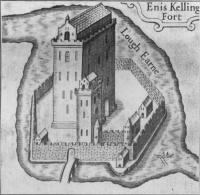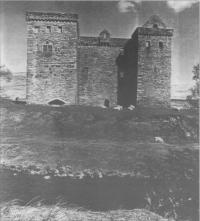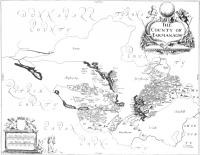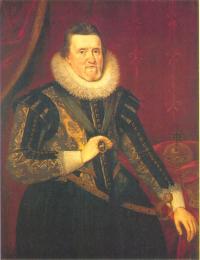‘Sheep stealers from the north of England’: the Riding Clans in Ulster by Robert Bell
Published in
20th Century Social Perspectives,
Early Modern History (1500–1700),
Features,
Gaelic Ireland,
Issue 4 (Winter 1994),
Volume 2
 The troubles of the last twenty five years have served to focus the minds of Ulster people on their history. They are more conscious than ever of their ancestors-Gaelic, Norman, English, Huguenot, Lowland Scot, Highland Scot. But that consciousness has neglected and all but forgotten one particularly influential immigrant group.
The troubles of the last twenty five years have served to focus the minds of Ulster people on their history. They are more conscious than ever of their ancestors-Gaelic, Norman, English, Huguenot, Lowland Scot, Highland Scot. But that consciousness has neglected and all but forgotten one particularly influential immigrant group.
Most often they are lumped in with the Lowland Scots. But while a majority of them were nominally Scottish, they were in fact a distinctively homogenous race who stemmed from a very particular region, with its own unique history and culture. Today, the only trace of them in the popular consciousness is that many by the name of Armstrong or Elliott, Graham, Johnston or Bell are dimly aware, to their mock chagrin, that their ancestors were ‘sheep stealers from the north of England’. Perhaps handed down through the generations, the phrase is a cosy blanket thrown over a wild and bloody history. The ancestors in question were the Riding Clans of the Scots Borders. Their official, and most accurate, designation was the Anglo-Scottish Border Reivers but these rustlers were known by a host of names: the Borderers, the Raiders, the Steel Bonnets, the Riding Clans, the Reivers.
Principal names
They began to arrive in Ulster during the seventeenth-century plantation. Among them were Sir John Hume and his brother Alexander who were granted 3,000 acres in Fermanagh. John bought out his brother and several others and became the greatest landowner in seventeenthcentury Fermanagh. However the vast majority of the Borderers did not come to Ulster as Undertakers or landlords, but as poor tenants. There is thus very little known about their migration. But their names start appearing on plantation records immediately. And by 1659, in Pender’s E nis Kel1i ng For.!J;:: census, they are listed as ‘principal names’ throughout the settlementArmstrong, Johnston, Elliott, Irvine, Graham, Nixon, Crozier, Bell, Kerr. And nowhere in the census are they more concentrated than in Fermanagh.
Pull was the operative factor for many of the tenant settlers who came to plantation Ulster; the attraction of plentiful land at cheap prices or no, or low, rents. For very many others, it was push; dissatisfaction with their conditions in Scotland or England. In the first two decades of the seventeenth century, no other migrants felt the push so forcefully as the Borderers. For English and lowland Scot settlers, plantation Ulster must have seemed a very dangerous place. For the Borderers, it represented a refuge compared to what they sought to escape-the ‘pacification’ of their homeland by James VI of Scotland/ James I of England. By the beginning of the seventeenth century, the Scots Borders had been home to a unique and distinctive social system for three hundred years. Throughout that period wars were fought between Scotland and England over and through the Borders, which were ravaged· and laid waste repeatedly by advancing and retreating armies, now of the English Crown, now of the Scottish. Partly because of the instability this caused and partly because of the kind of opportunities open to the inhabitants of any borderland anywhere, the Scots Borders quickly became, and then remained, lawless. Three centuries before, when the region had become the killing ground of an endemic national war, the Borderers found that a sense of patriotism was not only a lUxury iii-afforded, it was an impediment to survival. Under such conditions the only social structure that could offer security was kinship. There then arose in the Borders a complex network of greater or lesser families, not clans in the Gaelic sense, steeped in ancient culture, but clans more in the mafia sense, existing by intrigue and force of arms.

Hermitage Castle, ‘the Strength of
Liddesdale’, changed hands between
warring factions many times.
Predators
The clans became predators, routinely raiding deep into the northern counties of England or the southern counties of lowland Scotland and by blackmail, extortion, kidnapping, terror and murder, coming away with cattle, sheep and horses, with money, jewellery and household goods, denuding the settled citizens of both countries. On their run back to the border they could evade pursuit in Bewcastle Waste or in the folds of the Cheviot Hills. And if all else failed they could simply cross the border, beyond the jurisdiction of pursuing officers. Raiding parties would be small or large, would involve only one clan, or an alliance of two, three or more, and would be Scottish or English, or a mixture of both. Scots or English would as easily raid their own as the other’s country. Indeed, raiding was not only directed out of the Borders, . but within it, with clans preying on each other. To give some idea of scale, the Armstrongs, at their height in the sixteenth century, could put 3,000 men in the saddle at forty-eight hours notice, a sizeable force, wellversed in guerrilla warfare. And if the Armstongs were to ride out with their confederates, the Elliots, Nixons and Croziers, nothing less than a royal army could send them home again. Between national wars, the civil powers in Edinburgh and London made efforts to control their respective sides of the region. The Borders were divided into six Marches – a West, Middle and East March on each side. Each March was nominally under the authority of a royally designated Warden. Thus the Warden of the Scottish West March was empowered to co-operate with his counterpart in the English West March in the pursuit of fugitives. In practice, the intricacies of border c1anship were more than any outsider could fathom and invariably one strong clan within a March was granted the Wardenship and left to get on with policing the rest. Thus the authority of national law was corrupted into the hands of clan leaders who were themselves active in raiding. Competition for the Wardenship was fierce and this fed into the already endemic propensity of the clans to feud. The problem was deeply intractable and had remained so for three hundred years, until the death of Elizabeth I in March 1603.
End of an era
In the days that followed Robert Carey’s famous ride from London to Edinburgh to inform James of his accession to the throne of England, the Scots Borders erupted. In what would long be famous as’ ‘III Week’, the clans took advantage of the interregnum, broke loose all along the border and raided deep into England in search of plunder. The Grahams in particular were noted as taking the greatest liberties. Ironically this last great expression of the riding clan way of life coincided with the submission of Hugh O’Neill and Gaelic Ulster to the authority of the English crown at Mellifont. What now happened between London and Edinburgh was to send the broken rump of what had been the clans to Ulster and, in particular, to Fermanagh. Lawlessness on the Scots Borders was over. To James, the Scots Borders now represented his ‘Middle Shires’, through which he must needs travel between his courts. All six Marches now fell under his single jurisdiction. It is instructive that, faced with the daunting task of uniting two nations, his first policy decision was for the ‘pacification’ of the Borders. They had been a thorn in his side throughout his reign and having always had a ‘special regard to the Marchis and Bordouris’, he decreed that ‘the verie hart of the cuntrey sail not be left in ane uncertaintie’. The ‘pacification’ was ruthlessly pursued. The clans replied in their time-honoured fashion but against the powers of two states gathered in a single authority, it was only a matter of time. What had been ‘a lawless people, that will be Scottish when they will, and English at their pleasure’ had nowhere to hide. It took seven years to fully impose the rule of law on the Borders but the back of the job was broken in only four. In the first year alone almost 200 of the principle offenders, clan leaders, were dealt with. Thirty-two Armstrongs, Batys, Elliots, Johnstons and others were hanged. Fifteen more were sent into exile and 140 outlawed and in that year alone a force of 2,000 Scots left the region to fight for the Dutch in their war with Spain.
 Transplantation
TransplantationIn this terrible pogrom, no family suffered like the Grahams. Partly because they were the most hated clan on both sides of the border, and partly because their lands in Eskdale were among the most fertile in the Marches, they were singled out for the most severe treatment. The Border Commission had special instructions to deal with ‘the malefactors of the name of Graham’. Their lands were confiscated and they were hunted down, executed and transported in their hundreds. They were tried and hanged for their activities during ‘Ill Week’, for which a general pardon had supposedly been granted, and the Commission searched far back in the records for any crime that they could be arraigned for. In 1606, of the pitiful remnant of Grahams remaining in Eskdale, the Commission transported fifty families to Roscommon. Within two years their plantation there had diSintegrated and the Grahams had scattered. Though many returned home, enough of them caused such problems throughout Ireland that a suggestion was made that they be rounded up and re-transported to Ulster. The Irish lord deputy had the sense to leave them ‘dispersed’ for if they should be ‘placed upon any land together, the next country will find them ill neighbours’.
Those Roscommon Grahams who sought out kinsmen in Ulster must have been solaced by the numbers of Borderers they found already ensconced in the plantation counties, and in Antrim and Down, and the stream of others steadily arriving. Though a number of these were English Borderers, a first glance at a surnames map of the Borders reveals that the majority of those who came to Ulster were from the Scottish Marches, and in particular the West and the Middle, the toughest and most turbulent of the whole frontier.
A new frontier
Their numbers are very difficult to gauge, but they were large. During the 1641 rising, for instance, there were 260 Johnstons alone enlisted under Sir William Cole in Enniskillen.
Fermanagh had been filling with Borderers for thirty years. Their names appear everywhere in Ulster records of the first half of the seventeenth century but why did they so concentrate in Fermanagh? True, two of the family of the great Border Lords, the Humes had been granted land there. But, uniquely, the Humes were royal favourites and had implemented the pacification in the East March. Perhaps it was that Fermanagh, being on the frontier of the Plantation, suited the mentality of the Borderers. Perhaps too, it was as far as they could get from their homeland and from Edinburgh and London. The influence that they had there, and elsewhere in Ulster, can only be surmised. Two stories suggest that it was great. Firstly, where the plantation settlement in the other five planted counties was destroyed in the 1641 riSing, at its end Scots Border names still predominated in Fermanagh. Either holed up in Enniskillen throughout the rising, or by going to the fern as their ancestors had done for generations, they survived. To a young, undermanned garrison of civil Lowland peasants and English yeomen, they brought, in their blood, the skills of low intensity warfare, of the construction of weapons and the design of fortifications.
Nominally Catholic
The second fact provides the twist in the tale and goes some way towards explaining the religious history of Fermanagh, for the Scots Borderers were Catholics. The Reformation had been unable to penetrate so lawless a region. To be more accurate, they were nominally Catholic. In practice, they were godless. A sixteenth century traveller in what was known as the ‘cockpit’ of the Borders, on finding no churches, asked a Borderer ‘Are there no Christians in Liddesdale?’. To which he was answered ‘Na, we’s all Elliots and Armstrongs’! For the Borderers, religion can have played no part in their contribution to the early events of the Ulster conflict. Indeed, in some parts of Fermanagh settled by Borderers, no churches at all were built until the end of the seventeenth century. So we have them, godless, nominally Catholic, in a political environment where neither relationship with the Almighty could be tenable for ever. Over the century it would have become a political necessity for them to become Protestant. Being a political decision, unfettered by articles of faith, the church wherein all power lay was the obvious place to worship. This goes some way towards explaining why Protestant Fermanagh became and remains solidly Church of Ireland, the only one of the northern counties not dominated by Presbyterianism, to the continuing puzzlement of historians. The tenacity of these people in riding out the 1641 rising and beyond in Fermanagh is borne out by the surname statistics of the plantation counties in the present day. In Cavan, Donegal and Tyrone, all the top five most numerous names are Irish. In Armagh and Derry there is, at most, only one planter name in the first five. In Fermanagh, by sharp contrast, three of the most numerous county names stem from the Scottish West or the Scottish Middle Marches of the Scots Borders. In order, the five names are Maguire, Johnston, Armstrong, MacManus and Elliott.

James VI of Scotland by Adam de Colone
(COURTESY OF SCOTTISH NATIONAL PORTRAIT GALLERY)
A forgotten heritage
Why should the memory of this people have disappeared from the Ulster folk consciousness? In the case of many of them, the names were not particular to the Borders and were soon mingled with namesakes from Galloway or Yorkshire, or indeed with those Gaelic Irish families who adapted their names by anglicisation. The Borderers were a pragmatic people and, unlike the Gaels, Normans and Huguenots, were not noted for their literacy nor interest in lineage. They may have thought that the bad reputation which preceded them was best forgotten. Their history as nominal Catholics may have been one that they thought was better suppressed. Perhaps the memory of the seven years of ruthless pacification of the Borders was one which was only to be healed by a communal forgetting of the past, and a hard-headed digging in, as farmers, husbandmen and Protestants, in a new land with a new body politic. Poachers turned gamekeepers, they were no longer outlaws and had become key foot soldiers in a garrison. In general, Protestant people in present-day Ulster are relatively unaware of the history of their own names. There are none so unaware as those who still bear the once feared names of the Riding Clans of the Scots Marches. While the pacification destroyed the clan system and the entire social and economic infrastructure of the region, it did not rid the Borders of the names. Today, the most common name in the Carlisle phone book is not Smith, it is Graham and the Riding Clans themselves are remembered, especially in Scotland, thanks to the Border novels of Sir Walter Scott. He, himself, was a descendant of the Scotts, last Wardens of the Scottish West March, who implemented the pogrom there as the Humes did in the East March. But Ulster does not recollect them and equally, the Border people have forgotten that they have many cousins in the north of Ireland. It is as if this host departed their homeland, immediately forgot it and were immediately forgotten by it.
Hard men
There is surely enough in this story to suggest a working hypothesis that the Scots Borderers were the hard men of the plantation and provided the crucial leavening of an otherwise mediocre garrison throughout the settlement. More specifically, they held Enniskillen in the 1640s and their James VI of Scotland by Adam de C%ne (COURTESY OF SCOTTISH NATIONAL PORTRAIT GALLERY) sons and grandsons held it again during the Williamite campaign. If Enniskillen had fallen then, would Londonderry have held out?
Robert Bell is supervisor of the Northern Ireland political collection at the Linen Hall Library, Belfast.
Further reading:
R. Bell, The Book of Ulster Surnames
(Belfast 1988).
G.F. Frazer, The Steel Bonnets: the story of
the Anglo-Scottish Border Reivers (London
1989).
P. Livingstone, The Fermanagh Story: a
documented history of the County
Fermanagh from the earliest times to the
present day (Enniskillen 1969).
B.S. Turner, ‘A observation on settler
names in Fermanagh’, in Clogher Record
8/iii (1975).
 The troubles of the last twenty five years have served to focus the minds of Ulster people on their history. They are more conscious than ever of their ancestors-Gaelic, Norman, English, Huguenot, Lowland Scot, Highland Scot. But that consciousness has neglected and all but forgotten one particularly influential immigrant group.
The troubles of the last twenty five years have served to focus the minds of Ulster people on their history. They are more conscious than ever of their ancestors-Gaelic, Norman, English, Huguenot, Lowland Scot, Highland Scot. But that consciousness has neglected and all but forgotten one particularly influential immigrant group.
 Transplantation
Transplantation
















